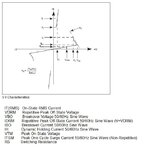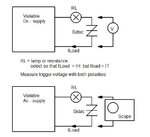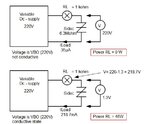phatcreators
Full Member level 5
How to test a Sidac ?
thanks
thanks
Follow along with the video below to see how to install our site as a web app on your home screen.
Note: This feature may not be available in some browsers.
How to test a Sidac ?


General Description
The Sidac is a silicon bilateral voltage triggered switch with
greater power-handling capabilities than standard diacs. Upon
application of a voltage exceeding the Sidac breakover voltage
point, the Sidac switches on through a negative resistance region
to a low on-state voltage. Conduction will continue until the current
is interrupted or drops below the minimum holding current of
the device.
Normally Vbo range 95 - 330 Volts
Example datasheet
http://www.play.com.br/datasheet/SIDAC.pdf
Sidac V/I Characteristics
View attachment 62721
Test circuit
View attachment 62720
I H ==> Dynamic Holding Current 50/60 Hz sine wave
IT (RSM) ==> On-State RMS Current
& Iload ==> Vload / RL , where Vload is ------ ? & RL is that Iload > IH & Iload < IT(RMS)
Am i right ?
Every Sidac has to be tested with both Variable DC Supply & Variable AC Supply one by one ???
What should be the values (Range) of AC & DC Supplies ?
What do you mean by that " Measure Trigger voltage with both polarities " ? Do you mean by that connect voltmeter (in DC V scale) when Red Probe on RL side & Common Probe on Iload side & then reverse the procedure like that, connect Common (Black) probe on RL side & Red Probe on Iload side ??
Yes
No, they represent alternative methods for testing. ( test with DC or with AC )
Look V/I - characteristics.
Test voltage must be higher than VBO ( Breakover voltage) so that SIDAC turns conductive and
voltage across component drops to VT ( On state voltage)
Same test must be done for both polarities +V and -V.
If you use AC-voltage and scope both voltage drops can observed simultaneous.
If Dc-voltage is used , measure first another half of characteristic
- find point VBO ( for example +V) = value where voltage drops to VT
- slowly increse voltage until you find that point
- then change polarity in supply and meter for measuring another half. (-V)
Look above
thanks what about Vload ?? How to evaluate its value ?

You can imagine SIDAC as two parallel thyristors in opposite directions , thyristor trigger at voltage VBO.
We can calculate dynamic resistance at VBO
Rdyn sidac = VBO / IBO
Look datasheet SIDAC MKP1V240
https://www.onsemi.com/pub_link/Collateral/MKP1V120-D.PDF
in page 2. Table : ON CHARACTERISTICS
VBO = 220V
IBO = 35µA
so Rdyn at point VBO is 6.3 Mohm
at this point sidac turns conductive
and voltage across sidac drops down to 1.3V
so we have two situations to handle
View attachment 62773
Here is one example more...............
View attachment 62812
With DC-supply and meter
same as above but...
-increase DC voltage slowly so that you can find value VBO and VT
ie max. value for voltage across the Sidac just before it drops down to VT
-do this with both polarity
You can imagine SIDAC as two parallel thyristors in opposite directions , thyristor trigger at voltage VBO.
We can calculate dynamic resistance at VBO
Rdyn sidac = VBO / IBO
Look datasheet SIDAC MKP1V240
https://www.onsemi.com/pub_link/Collateral/MKP1V120-D.PDF
in page 2. Table : ON CHARACTERISTICS
VBO = 220V
IBO = 35µA
so Rdyn at point VBO is 6.3 Mohm
at this point sidac turns conductive
and voltage across sidac drops down to 1.3V
so we have two situations to handle
View attachment 62773